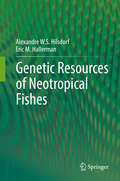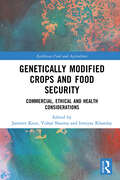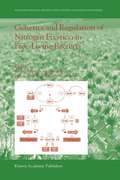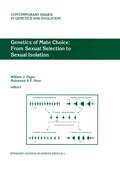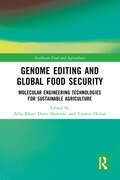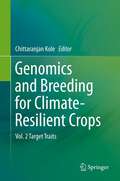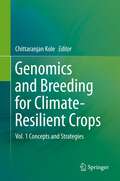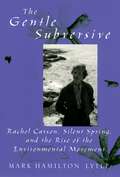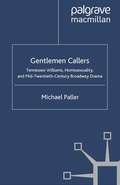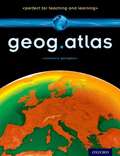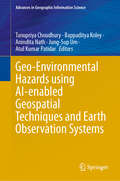- Table View
- List View
Genetic Manipulation in Plants for Mitigation of Climate Change
by Pawan Kumar Jaiwal Rana Pratap Singh Om Parkash DhankherThis book presents a detailed overview and critical evaluation of the state of the art and latest approaches in genetic manipulation studies on plants to mitigate the impact of climate change on growth and productivity. Each chapter has been written by experts in plant-stress biology and highlights the involvement of a variety of genes/pathways and their regulation in abiotic stress, recent advances in molecular breeding (identification of tightly liked markers, QTLs/genes), transgenesis (introduction of exogenous genes or changing the expression of endogenous stress- responsive genes) and genomics approaches that have made it easier to identify and isolate several key genes involved in abiotic stress such as drought, water lodging/flooding, extreme temperatures, salinity and heavy-metal toxicity.Food and nutritional security has emerged as a major global challenge due to expanding populations, and cultivated areas becoming less productive as a result of extreme climatic changes adversely affecting the quantity and quality of plants. Hence, there is an urgent need to develop crop varieties resilient to abiotic stress to ensure food security and combat increased input costs, low yields and the marginalization of land.The role of GM crops in poverty alleviation, nutrition and health in developing countries and their feasibility in times of climate change are also discussed. Recent advances in gene technologies have shown the potential for faster, more targeted crop improvements by transferring genes across the sexual barriers. The book is a valuable resource for scientists, researchers, students, planners and industrialists working in the area of biotechnology, plant agriculture, agronomy, horticulture, plant physiology, molecular biology, plant sciences and environmental sciences.
Genetic Resources of Mediterranean Pasture and Forage Legumes (Current Plant Science and Biotechnology in Agriculture #33)
by Sarita Jane Bennett P. S. CocksGenetic Resources of Mediterranean Pasture and Forage Legumes is a comprehensive review of grassland improvement in Mediterranean areas using legume species. The book includes a detailed account of the processes involved in understanding the ecology of legumes and their collection in the Mediterranean, through to their preliminary evaluation and storage at various Genetic Resource Centres. A generic conspectus and key to the forage legumes of the Mediterranean basin is also included. These proceedings are truly international with examples on the collection and use of Mediterranean genetic resources being illustrated by Genetic Resource Centres in Australia, Cyprus, France, Greece, Syria, Turkey and Tunisia. Current important issues such as the sustainability of Mediterranean grasslands, the risk of genetic erosion and the principles of population genetics employed during a collecting mission are discussed. The book will be of value to researchers working in the fields of grassland and rangeland improvement, Mediterranean farming systems, genetic resources, and pasture and forage ecology.
Genetic Resources of Neotropical Fishes
by Alexandre W. Hilsdorf Eric M. HallermanThe aim of this book is to systematize and discuss population genetic studies of freshwater fish in a region that harbors the greatest diversity of species among all inland water ecosystems. This volume explores the genetic evaluation for a number of orders, families and species of Neotropical fishes, and provides an overview on genetic resources and diversity and their relationships with fish domestication, breeding, and food production.
Genetically Modified Crops and Food Security: Commercial, Ethical and Health Considerations (Earthscan Food and Agriculture)
by Jasmeet Kour Vishal Sharma Imtiyaz KhandayThis book reviews a wide-range of genetically modified (GM) crops to understand how they are produced, the impacts on the agricultural industry, and their potential for improving food security. The production of GM crops has now become an invaluable asset in the agricultural toolbox. With a significant portion of the world suffering from hunger and poverty, this book examines how food security can be achieved through GM crops. A wide variety of crops are examined, from the earliest developments of GM tomatoes and potatoes to recent interest in the development of low-cost, high yielding biofuels, such as microalgae. Chapters also discuss the role of GM crops in pest management and the consequential reduction in the use of insecticides. Overall, this book provides an important synthesis of GM crops from their commercial value to the agricultural industry, as well as their potential for improving food security. This book will be of great interest to students and scholars of agricultural engineering, crop science, food biotechology, food security, and those interested in food and agriculture and sustainable development more broadly.
Genetically Modified Crops and Food Security: Commercial, Ethical and Health Considerations (Earthscan Food and Agriculture)
by Jasmeet Kour Vishal Sharma Imtiyaz KhandayThis book reviews a wide-range of genetically modified (GM) crops to understand how they are produced, the impacts on the agricultural industry, and their potential for improving food security. The production of GM crops has now become an invaluable asset in the agricultural toolbox. With a significant portion of the world suffering from hunger and poverty, this book examines how food security can be achieved through GM crops. A wide variety of crops are examined, from the earliest developments of GM tomatoes and potatoes to recent interest in the development of low-cost, high yielding biofuels, such as microalgae. Chapters also discuss the role of GM crops in pest management and the consequential reduction in the use of insecticides. Overall, this book provides an important synthesis of GM crops from their commercial value to the agricultural industry, as well as their potential for improving food security. This book will be of great interest to students and scholars of agricultural engineering, crop science, food biotechology, food security, and those interested in food and agriculture and sustainable development more broadly.
Genetics and Regulation of Nitrogen Fixation in Free-Living Bacteria (Nitrogen Fixation: Origins, Applications, and Research Progress #2)
by Werner Klipp Bernd Masepohl John R. Gallon William E. NewtonGenetics and Regulation of Nitrogen-Fixing Bacteria This book is the second volume of a seven-volume series, which covers all fields of research related to nitrogen fixation - from basic studies through applied aspects to environmental impacts. Volume II provides a comprehensive and detailed source of information concerning the genetics and regulation of biological nitrogen fixation in free-living prokaryotes. This preface attempts to provide the reader with some insight into how this volume originated, how it was planned, and then how it developed over the several years of its production. Once the editorial team was established, the first job was to decide which of the many free-living diazotrophs that have been subjected to genetic analysis should be included in this volume. Would we need to develop specific criteria for selection or would the organisms, in effect, select themselves? Of course, Klebsiella pneumoniae and Azotobacter vinelandii, which have served (and still serve) as the main model organisms for the genetic analysis of diazotrophy, plus some of the other bacteria described in this volume, did indeed select themselves. However, there was considerable discussion surrounding well-characterized fixing species, like Azorhizobium caulinodans and Herbaspirillum seropedicae, both of which are able to fix atmospheric N under free-living conditions.
Genetics of Mate Choice: From Sexual Selection to Sexual Isolation (Contemporary Issues in Genetics and Evolution #9)
by W. J. Etges M. A. NoorGenetic studies aimed at understanding the origin of species are dominating major scientific journals. In the past decade, genetic tools that were previously available only in model systems have become accessible to investigators working on nearly all species. Concurrent with these technical advances has been an increase in understanding of both the importance of considering the ecological context of speciation and testing hypotheses about causes for species formation. Many recent studies suggest a prominent role of sexual selection in species formation. These advances have produced a need for a synthesis of what we now understand about speciation, and perhaps more importantly, where we should go from here. In this volume, several leading investigators and rising stars have contributed reviews and/or novel primary research findings aimed at understanding the ultimate mystery on which Darwin named his most famous and influential book. Fundamental to the origin of species is the evolution of mate choice systems. This collection of papers discusses burgeoning genetic, evolutionary, and ecological approaches to understanding the origins of mating discrimination and causes of premating reproductive isolation both within and between species. The individual contributions span a wide spectrum of disciplines, taxa, and ideas (some controversial). This synthesis brings together several of the most recent ideas with supporting empirical data. This book will be of particular interest to both undergraduate and postgraduate researchers and students and researchers in the field of evolutionary biology, genetics and animal behaviour.
Genetics of Salt Tolerance in Plants: A Central Dogma Perspective and Strategies for Enhancement
by Kehinde A. Adeboye Victor J. Bamisaye Farwa Basit Usman Rabi’u Bello Javaid Akhter Bhat Jamindar Buddiga Utpal Das Balasundari Dharbaranyam Xianzhong Feng M. Gayathri Abubakar Mohammad Gumi Md Sazzad Hossain Emmanuel O. Idehen Krishnananda P. Ingle Nancy McMulkin Mushtaq Ahmad Najar Oyeboade A. Oyetunde Kapil Patil Britta Pitann Shiva Sai Prasad Fergie Ann Quilloy Md Zillur Rahman J. R. Rajeshwar P. W. Ramteke Hamza Ramzan Vincent Pamugas Reyes Kausalya Sakthivel Palanisamy Senthilmurugan Usama Sheraz Sajid Shokat Pradeep Kumar Shukla Atul Singh Gayatri Venkataraman Mst Ishrat ZahanGene expression in cells follows a prescribed pathway that conforms to the Central Dogma; where the genetic information stored in DNA is transcribed into RNA and then expressed into proteins, which influences most plant traits. Plant salt tolerance research is directed towards identifying nucleotide variants that could contribute to tolerant phenotypes. This book comprehensively presents the current state of knowledge on plant salt tolerance through meticulous analysis of the processes operating across the Central Dogma. It provides a detailed account of modulation of gene expression through genome editing systems to achieve crop improvement against salt stress. It also provides state-of-the-art information on advances in breeding technologies of genome selection and accelerated de novo domestication for rapidly improving the salt tolerance of plants for global food security. This book: 1.Provides a comprehensive coverage of plant salt tolerance mechanisms. 2.Spotlights various factors functioning along the Central Dogma pathway and their regulation in response to salinity. 3.Examines how these factors function to protect the plants from high salinity. 4.Highlights advances in cutting-edge breeding technologies for improving salt tolerance. The book will be of particular value to students and researchers of plant genetics, molecular biology and physiology and those with an interest in salinity and salt tolerance.
Genome Editing and Global Food Security: Molecular Engineering Technologies for Sustainable Agriculture (Earthscan Food and Agriculture)
by Zeba Khan Durre Shahwar Yasmin HeikalWith the rapid increase in the global population and changing climatic impacts on agriculture, this book demonstrates how genome editing will be an indispensable technique to overcome ongoing and prospective agricultural challenges. This book examines the role of genome editing in improving crop yields and contributing to global food security. It summarizes a range of genome editing techniques and discusses the roles they can play in producing a new generation of high-yielding, climate-ready crops. This includes site-specific nucleases, precision genome engineering, clustered regularly interspaced short palindromic repeats, and bioinformatics. It showcases how these gene editing techniques can tailor plants to not only increase yield-related traits but to also make them better suited to their environment and to be resistant to pests and extreme climatic events, such as droughts. The book also examines genome editing regulations and policies, the commercialization of genome-edited crops, and biosafety and biosecurity concerns. Overall, this book reveals and showcases how genome editing can improve crop resilience and production to address current and future agricultural challenges and alleviation of global food security concerns. This book will be of great interest to students and scholars of agricultural science, crop and plant science, genome editing, sustainable agriculture, biotechnology, and food security.
Genome Editing and Global Food Security: Molecular Engineering Technologies for Sustainable Agriculture (Earthscan Food and Agriculture)
With the rapid increase in the global population and changing climatic impacts on agriculture, this book demonstrates how genome editing will be an indispensable technique to overcome ongoing and prospective agricultural challenges. This book examines the role of genome editing in improving crop yields and contributing to global food security. It summarizes a range of genome editing techniques and discusses the roles they can play in producing a new generation of high-yielding, climate-ready crops. This includes site-specific nucleases, precision genome engineering, clustered regularly interspaced short palindromic repeats, and bioinformatics. It showcases how these gene editing techniques can tailor plants to not only increase yield-related traits but to also make them better suited to their environment and to be resistant to pests and extreme climatic events, such as droughts. The book also examines genome editing regulations and policies, the commercialization of genome-edited crops, and biosafety and biosecurity concerns. Overall, this book reveals and showcases how genome editing can improve crop resilience and production to address current and future agricultural challenges and alleviation of global food security concerns. This book will be of great interest to students and scholars of agricultural science, crop and plant science, genome editing, sustainable agriculture, biotechnology, and food security.
Genomics and Breeding for Climate-Resilient Crops: Vol. 2 Target Traits
by Chittaranjan KoleClimate change is expected to have a drastic impact on agronomic conditions including temperature, precipitation, soil nutrients, and the incidence of disease pests, to name a few. To face this looming threat, significant progress in developing new breeding strategies has been made over the last few decades. The second volume of Genomics and Breeding for Climate-Resilient Crops describes various genomic and breeding approaches for the genetic improvement of the major target traits. Topics covered include: flowering time; root traits; cold, heat and drought tolerance; water use efficiency; flooding and submergence tolerance; disease and insect resistance; nutrient use efficiency; nitrogen fixation; carbon sequestration; and greenhouse gas emissions.
Genomics and Breeding for Climate-Resilient Crops: Vol. 1 Concepts and Strategies
by Chittaranjan KoleClimate change is expected to have a drastic impact on agronomic conditions including temperature, precipitation, soil nutrients, and the incidence of disease pests, to name a few. To face this looming threat, significant progress in developing new breeding strategies has been made over the last few decades. The first volume of Genomics and Breeding for Climate-Resilient Crops presents the basic concepts and strategies for developing climate-resilient crop varieties. Topics covered include: conservation, evaluation and utilization of biodiversity; identification of traits, genes and crops of the future; genomic and molecular tools; genetic engineering; participatory and evolutionary breeding; bioinformatics tools to support breeding; funding and networking support; and intellectual property, regulatory issues, social and political dimensions.
Genomics of Antibiotic Resistant Bacteria in Industrial Waste Water Treatment
by Maulin P. ShahThis book discusses the key problems and solutions with various applicable approaches to combat antibiotic-resistant genes in industrial waste water. Several genes are selected within the chapters to illustrate the past and future roles of molecular ecophysiology and genomics in the development of wastewater microbiology as an important subdiscipline of microbial ecology. As we have very limited knowledge of composition, dynamics and stability of microbial communities, various processes in wastewater treatment have been generally considered to be "black box." In recent years, with the development of several new high throughput sequencing platforms, metagenome sequencing strategies and bioinformatics toolboxes, the analysis of the genome of complex communities has become much more accessible and means easier.The opening of the biological wastewater treatment “black box” is not the unpleasant experience it was before. The viable, but not cultural, ceases tobe the inconsequential, uncharacterizable enigma that existed today. Metagenomics leads the way for more specific studies in related fields. Finally, genomic studies of wastewater treatment microbes, in addition to their biotechnological applications, are also an excellent testing ground for variety of other ecological and environmental burns questions. Wastewater treatment plants are considered hotspots for the environmental dissemination of antimicrobial-resistant determinants. Comparative genomics of antibiotic resistant genes isolated from conventional activated sludge and biological aerated filter wastewater treatment plants is discussed.
Genomics of Soil- and Plant-Associated Fungi (Soil Biology #36)
by Benjamin A. Horwitz, Prasun K. Mukherjee, Mala Mukherjee and Christian P. KubicekThis volume addresses the similarities and also the differences in the genomes of soil saprophytes, symbionts, and plant pathogens by using examples of fungal species to illustrate particular principles. It analyzes how the specific interactions with the hosts and the influence of the environment may have shaped genome evolution. The relevance of fungal genetic research and biotechnological applications is shown for areas such as plant pathogenesis, biomass degradation, litter decomposition, nitrogen assimilation, antibiotic production, mycoparasitism, energy, ecology, and also for soil fungi turning to human pathogens. In addition to the model organisms Neurospora and Aspergillus, the following species are covered providing a view of pathogens and mutualists: Trichoderma, Fusarium oxysporum, Cochliobolus heterostrophus, Penicillium chrysogenum, Rhizopus oryzae, Podospora anserina, and species belonging to Agaricomycetes, Archaeorhizomycetes and Magnaporthaceae. Ecology and potential applications have guided the choice of fungal genes to be studied and it will be fascinating to follow the trends of future sequencing projects.
The Gentle Subversive: Rachel Carson, Silent Spring, and the Rise of the Environmental Movement (New Narratives in American History)
by Mark Hamilton LytleRachel Carson's Silent Spring antagonized some of the most powerful interests in the nation--including the farm block and the agricultural chemical industry--and helped launch the modern environmental movement. In The Gentle Subversive, Mark Hamilton Lytle offers a compact biography of Carson, illuminating the road that led to this vastly influential book. Lytle explores the evolution of Carson's ideas about nature, her love for the sea, her career as a biologist, and above all her emergence as a writer of extraordinary moral and ecological vision. We follow Carson from her childhood on a farm outside Pittsburgh, where she first developed her love of nature (and where, at age eleven, she published her first piece in a children's magazine), to her graduate work at Johns Hopkins and her career with the Fish and Wildlife Service. Lytle describes the genesis of her first book, Under the Sea-Wind, the incredible success of The Sea Around Us (a New York Times bestseller for over a year), and her determination to risk her fame in order to write her "poison book": Silent Spring. The author contends that despite Carson's demure, lady-like demeanor, she was subversive in her thinking and aggressive in her campaign against pesticides. Carson became the spokeswoman for a network of conservationists, scientists, women, and other concerned citizens who had come to fear the mounting dangers of the human assault on nature. What makes this story particularly compelling is that Carson took up this cause at the very moment when she herself faced a losing battle with cancer. Succinct and engaging, The Gentle Subversive is a story of success, celebrity, controversy, and vindication. It will inspire anyone interested in protecting the natural world or in women's struggle to find a voice in society.
The Gentle Subversive: Rachel Carson, Silent Spring, and the Rise of the Environmental Movement (New Narratives in American History)
by Mark Hamilton LytleRachel Carson's Silent Spring antagonized some of the most powerful interests in the nation--including the farm block and the agricultural chemical industry--and helped launch the modern environmental movement. In The Gentle Subversive, Mark Hamilton Lytle offers a compact biography of Carson, illuminating the road that led to this vastly influential book. Lytle explores the evolution of Carson's ideas about nature, her love for the sea, her career as a biologist, and above all her emergence as a writer of extraordinary moral and ecological vision. We follow Carson from her childhood on a farm outside Pittsburgh, where she first developed her love of nature (and where, at age eleven, she published her first piece in a children's magazine), to her graduate work at Johns Hopkins and her career with the Fish and Wildlife Service. Lytle describes the genesis of her first book, Under the Sea-Wind, the incredible success of The Sea Around Us (a New York Times bestseller for over a year), and her determination to risk her fame in order to write her "poison book": Silent Spring. The author contends that despite Carson's demure, lady-like demeanor, she was subversive in her thinking and aggressive in her campaign against pesticides. Carson became the spokeswoman for a network of conservationists, scientists, women, and other concerned citizens who had come to fear the mounting dangers of the human assault on nature. What makes this story particularly compelling is that Carson took up this cause at the very moment when she herself faced a losing battle with cancer. Succinct and engaging, The Gentle Subversive is a story of success, celebrity, controversy, and vindication. It will inspire anyone interested in protecting the natural world or in women's struggle to find a voice in society.
Gentlemen Callers: Tennessee Williams, Homosexuality, and Mid-Twentieth-Century Drama
by M. PallerGentlemen Callers provides a fascinating look at America's greatest Twentieth-century playwright and perhaps the most-performed, even today. Michael Paller looks at Tennessee Williams's plays from the 1940s through the 1960s against the backdrop of the playwright's life story, providing fresh details. Through this lens Paller examines the evolution of Mid-Twentieth-century America's acknowledgment and acceptance of homosexuality. From the early Cat on a Hot Tin Roof and one-act Auto-da-Fé , through The Two-Character Play and Something Cloudy, Something Clear , Paller's book investigates how Williams's earliest critics marginalized or ignored his gay characters and why, beginning in the 1970s, many gay liberationists reviled them. Lively, blunt, and provocative, this book will appeal to anyone who loves Williams, Broadway, and the theater.
Gentrification and Displacement: The Forced Relocation of Public Housing Tenants in Inner-Sydney (SpringerBriefs in Sociology)
by Alan MorrisThis book examines the forced displacement of public housing residents in Sydney’s Millers Point and The Rocks communities. It considers the strategies deployed by the government to pressure tenants to move, and the social and personal impacts of the displacement on the residents themselves. Drawing on in-depth interviews with tenants alongside government and media communications, the Millers Point case study offers a penetrating and moving analysis of gentrification and displacement in one of Australia’s oldest and more unique working class and public housing neighbourhoods. Gentrification and Displacement advances work in urban studies by charting trends in urban renewal and displacement, furthering our understanding of public housing, gentrification and the effects of forced relocation on vulnerable urban communities.
Gentrification as a Global Strategy: Neil Smith and Beyond (Routledge Critical Studies in Urbanism and the City)
by Abel Albet Núria BenachThis book pays homage to Neil Smith’s ideas, offering a critical approach and rich collection of insights that draw on Smith’s work for inspiration and debate. With interdisciplinary and international contributions from leading experts, the book demonstrates the impact of Smith’s ideas on understanding the role of urbanisation in general and gentrification, in particular, in contemporary society. The book demonstrates how gentrification varies significantly from city to city, across different cultural and political-economic regimes, and in terms of the timing of urban transformations. This collection provides a forum for debate for those working in urban regeneration and citizenship, and those directly affected by the processes and problems arising from gentrification. It will be of interest to students and scholars in urban geography, urban sociology, cultural studies, and wider social and urban theories.
Gentrification as a Global Strategy: Neil Smith and Beyond (Routledge Critical Studies in Urbanism and the City)
by Abel Albet Núria BenachThis book pays homage to Neil Smith’s ideas, offering a critical approach and rich collection of insights that draw on Smith’s work for inspiration and debate. With interdisciplinary and international contributions from leading experts, the book demonstrates the impact of Smith’s ideas on understanding the role of urbanisation in general and gentrification, in particular, in contemporary society. The book demonstrates how gentrification varies significantly from city to city, across different cultural and political-economic regimes, and in terms of the timing of urban transformations. This collection provides a forum for debate for those working in urban regeneration and citizenship, and those directly affected by the processes and problems arising from gentrification. It will be of interest to students and scholars in urban geography, urban sociology, cultural studies, and wider social and urban theories.
Gentrification in Chinese Cities: State Institutions, Space and Society (Urban Sustainability)
by Qinran YangThis book provides an institutional interpretation of state-facilitated gentrification in Chengdu, an emerging central city of China. It generalizes the three aspects of institutional changes in the cultural, economic and social spheres that have thus far directed the operation of gentrification in the transitional economy: the creative destruction of consumption spaces, the spatial production of excess, and the unequal redistribution of spatial resources to low-income residents. The interactions of state and society, are examined in navigating the institutional changes and forming the Chinese distinctions of gentrification. The author argues that these three aspects of institutional changes characterize gentrification in Chengdu as a transformative force of development led by the state and capitalists and championed by middle-class consumers. This gentrification mode periodically catalyzes new spaces and collective cultures, which then necessitate the stimulation of new consumption behaviors and the formation of new consumer classes, at the expense of the spatial demands for the even larger number of low-income residents. However, in the context of China's unique state–society relations, some low-income groups may also ride the wave of social transformation. The author suggests that this type of gentrification integrates into not the essence of uneven geographical development in a capitalist society, but China’s unique model of urbanization and development, which is often state-driven, innovative and even involuted so as to sustain continuous growth. Though the research is focused on urban China, this book also contributes to methodological issues on gentrification research on a global scale. It is skeptical both of the structural explanation and of the revelation of unsorted differences; instead, it aims to generate midrange regularities of gentrification in Chinese cities. Institutional change is treated as an intermediary that, on the one hand, responds to the global trends and, on the other hand, adapts to local preconditions. Mixed methods, including statistical and spatial analysis, institutional analysis, and an extensive ethnographic study, are used to investigate gentrification from a structural perspective, a historical perspective, and as a grounded process within the locality.
Geo.123: geog.atlas (3rd edition) (PDF)
by Rose Marie Gallaghergeog.atlas is an engaging atlas of accessible maps and supporting information. It features unique coverage of places likely to appear in the news, such as the Middle East, Afghanistan, and the Falklands. Special maps look at themes like global warming, desertification, and how people spread around the world. Stunning satellite images are placed alongside physical geography maps to aid understanding. Full of clearly-labelled maps, straightforward explanations, and advice on how to 'read' maps and understand what they show, it will help improve students' basic locational knowledge, enhance their understanding, and build their confidence.
Geo-disaster Modeling and Analysis: An Sph-based Approach (Springer Natural Hazards)
by Yu Huang Zili Dai Weijie ZhangThrough application of the Smoothed Particle Hydrodynamics (SPH) method, this monograph mainly focuses on large deformations and flow failure simulations of geomaterials and movement behavior, which are always involved in geo-disasters. The work covers the theoretical background, numerical techniques, code implementation issues, and many novel and interesting applications. Two-dimensional and three-dimensional SPH models in the framework of both hydrodynamics and solid mechanics are established, with detailed descriptions. The monograph also contains many appealing and practical examples of geo-disaster modeling and analysis, including the fluidized movement of flow-like landslides, lateral spread of liquefied soils, and flow slides in landfills. In the documented SPH simulations, the propagation of geo-disasters is effectively reproduced. Dynamic behaviors of geomaterials during propagation are ascertained, including sliding path, flow velocity, maximum distance reached, and distribution of deposits. In this way, the monograph presents a means for mapping hazardous areas, estimating hazard intensity, and identifying and designing appropriate protective measures.
Geo-Environmental Hazards using AI-enabled Geospatial Techniques and Earth Observation Systems (Advances in Geographic Information Science)
by Jung-Sup Um Tanupriya Choudhury Bappaditya Koley Anindita Nath Atul Kumar PatidarThis edited collection provides a comprehensive exploration of cutting-edge ideas, approaches, simulations, evaluations of risk, and systems that enhance the practicality of current geospatial technologies for reducing hazard risks. The various sections within this book delve into subjects such as the foundational principles of Earth Observation Systems (EOS) and geospatial methodologies. Additionally, the text serves as an advisory resource on the collaborative use of satellite-derived data and artificial intelligence to track and alleviate geo-environmental threats. The volume imparts extensive understanding regarding geo-environmental dangers and their analysis via EOS along with geospatial strategies. It encompasses key hazard-related themes including coastal degradation, predisposition to landslides, mapping vegetation coverages, tropical storm patterns, soil depletion due to erosion processes, vulnerability to rapid or extended flooding events, variations in oceansurface temperatures alongside chlorophyll-a levels; it also addresses assessments related to groundwater reserves and quality measures as well as sustainable management practices for watersheds that support community livelihoods—all through leveraging AI-integrated geospatial tools in conjunction with earth observation technologies. Furthermore, this work engages in discourse about systems designed for mitigating these ecological challenges sustainably. Scholars engaged in research activities; educational professionals; those involved in landscape design; engineers working at ground level; individuals responsible for policy-making—all who are concerned with geo-environmental hazards or associated domains—will find valuable insights within these pages.
The GEO Handbook on Biodiversity Observation Networks
by Michele Walters Robert J. ScholesBiodiversity observation systems are almost everywhere inadequate to meet local, national and international (treaty) obligations. As a result of alarmingly rapid declines in biodiversity in the modern era, there is a strong, worldwide desire to upgrade our monitoring systems, but little clarity on what is actually needed and how it can be assembled from the elements which are already present. This book intends to provide practical guidance to broadly-defined biodiversity observation networks at all scales, but predominantly the national scale and higher. This is a practical how-to book with substantial policy relevance. It will mostly be used by technical specialists with a responsibility for biodiversity monitoring to establish and refine their systems. It is written at a technical level, but one that is not discipline-bound: it should be intelligible to anyone in the broad field with a tertiary education.


